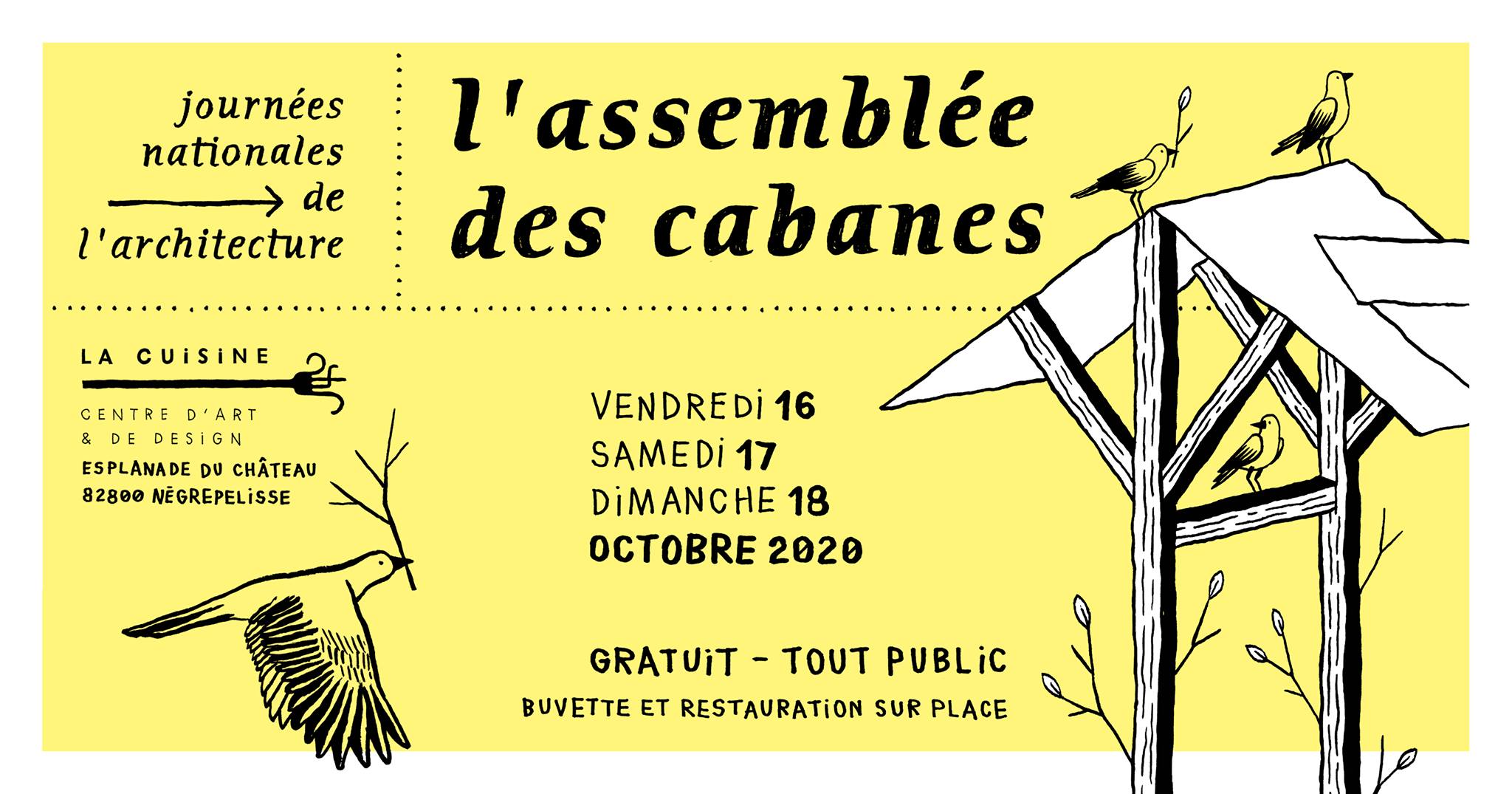
- This event has passed.
L’ASSEMBLÉE DES CABANES, VIVRE DANS UN MONDE ABÎMÉ
THE ASSEMBLY OF THE HUTS, LIVING IN A DAMAGED WORLD
Journées Nationales de L'architecture 2020
National Architecture Days 2020

OUR PARTNERS
SHARE
Habiter en 2020 quand le rapport à la nature est réinterrogé, quand la matérialisation d’un monde fini prend de plus en plus sens, impose aux architectes une réflexion et une introspection sur leurs manières de penser et pratiquer l’architecture. La cabane, archétype de protection face aux éléments naturels et aux regards d’autrui, symbolise le premier acte de réflexion, un acte d’intégration dans un milieu, qu’il soit hostile ou accueillant.
« Faire des cabanes : imaginer des façons de vivre dans un monde abîmé. Trouver ou atterrir, sur quel sol ré-éprouvé, sur quelle terre repensée, prise en pitié et en piété. Mais aussi sur quels espaces en lutte, discrets ou voyants, sur quel territoire défendu dans la mesure même où ils sont ré-habités cultivés, imaginés, ménagés, plutôt qu’aménager. »[1]
Pour les architectes du 20e siècle, la cabane est un modèle de fonctionnalité et de simplicité. Objet vernaculaire intuitif et pensé, ils l’observent, l’étudient, la pensent, la multiplient et la reproduisent pour nourrir les imaginaires autour de l’architecture ou pour expérimenter à l’échelle de l’humain ce qu’ils reproduisent à l’échelle des territoires ; une architecture qui est nécessairement en relation aux vivants et à leur environnement. La cabane est aujourd’hui un exercice incontournable dans l’acte de bâtir et plus globalement de la pratique architecturale, une pratique responsable en adéquation avec tout et tous ceux et celles qui l’entourent. Dans sa dimension comme dans l’expression la plus simple du bon sens, constructif et primitif, la cabane nous ramène à notre condition humaine, la plus intime et la mieux partagée.
L’enseignement que nous avons reçu tend à nous montrer que seul l’homme habite le monde. Aujourd’hui de nombreux chercheur réinterrogent cette position : L’assemblée des cabanes, propose de changer d’ontologie, de passer d’un monde anthropocentré à un monde éco-bio-centré, elle expérimente la cabane, comme premier pas pour ménager le monde
La cabane est peut-être une leçon, pour repenser nos besoins, nos façons d’habiter.
Cette année, pour les Journées Nationales de l’Architecture, La cuisine vous invite à penser la cabane autrement pour imaginer des façons de vivre ensemble et secouer notre mode de vie.
Faire des cabanes : imaginer des façons de vivre dans un monde abîmé. Loin d’être des lieux de précarité, de retrait ou de repli pour, bien au contraire, les vouloir pleins de vie, d’idées, d’inventions. C’est une invitation à rêver, à lâcher prise, à réinventer sans cesse, à matérialiser nos rêves, les rendre visibles et les partager.
La cuisine pourrait-elle être la scène d’une Assemblée des Cabanes où se formule le vœu que ce monde si menacé, qui épuise ses ressources naturelles, devienne un monde à nous, une terre pour nous tous, à notre échelle, celle de nos désirs et de nos possibilités ?
En commençant à cohabiter dans la cour de la cuisine, les performances, discussions et rituels nous invitent vers un monde où nous ne nous distancions pas de la nature. La cour est devenue une noue ce lieu où l’on prend soin de nous, des autres, du vivant de la terre. Les communs déjà réalisés nous permettent de nous installer dans ce lieu remarquable et moderne, ensemble, nous construirons des cabanes, pour tenter de nous re-sensibiliser et nous réconcilier avec le vivant.
Nous y interrogeons nos communs et les façons d’habiter la nature et ce monde fini.
Pendant un an nous avons co-pensé, co-construit les JNA, les cabanes construites par des collectifs, des groupes d’artistes, d’architectes, d’étudiants, de penseurs, de rêveurs, d’urbanistes, … d’humains (trop ?)
Nous tentons l’expérience de ce nous, ou l’art et l’architecture sont des vecteurs de réconciliation : un jardin forêt pour cultiver, une canopée pour s’abriter, des arbres pour tisser des liens, du mobilier pour échanger, rire, discuter, ripailler, une table « pour un repas normal en temps de covid» pour une nouvelle normalité que nous proposons de définir ensemble.
L’Assemblée des Cabanes est le premier acte du programme triennal « Réconciliation », qui a pour but de recréer du lien et rendre habitable et habité La cuisine, centre d’art et de design à Nègrepelisse.
Le collectif de programmation des JNA20
Marta Jonville, Franck Boyer, Joanne Pouzenc, Philippe Millasseau
"Making huts: imagining ways of living in a damaged world. Finding or landing, on what land, on what rethought land, taken in pity and piety. But also on what spaces in struggle, discreet or conspicuous, on what defended territory, inasmuch as they are re-habited, cultivated, imagined, managed, rather than developed. »[1]
For 20th century architects, the hut is a model of functionality and simplicity. An intuitive and thoughtful vernacular object, they observe, study, think, multiply and reproduce it to feed the imaginations around architecture or to experiment on a human scale what they reproduce on the scale of territories; an architecture that is necessarily in relation to living beings and their environment. The hut is today an essential exercise in the act of building and, more globally, in architectural practice, a responsible practice in keeping with everything and everyone around it. In its dimension as in the simplest expression of common sense, constructive and primitive, the hut brings us back to our most intimate and shared human condition.
The teaching we have received tends to show us that only man inhabits the world. Today, many researchers are reexamining this position: The hut assembly proposes to change ontology, to move from an anthropocentric world to an eco-bio-centric world, and is experimenting with the hut as a first step in protecting the world.
The hut is perhaps a lesson, to rethink our needs, our ways of living.
This year, for the National Architecture Days, La cuisine invites you to think differently about the hut, to imagine ways to live together and shake up our way of life.
Making huts: imagining ways of living in a damaged world. Far from being places of precariousness, of withdrawal or withdrawal to, on the contrary, want them full of life, ideas, inventions. It is an invitation to dream, to let go, to constantly reinvent, to materialize our dreams, to make them visible and share them.
Could the kitchen be the scene of an Assembly of the Shacks where the wish is expressed that this world so threatened, which is depleting its natural resources, becomes a world of our own, a land for all of us, on our own scale, that of our desires and our possibilities?
As we begin to cohabit in the kitchen courtyard, performances, discussions and rituals invite us towards a world where we do not distance ourselves from nature. The courtyard has become a knot, a place where we take care of ourselves, of others, of the living of the earth. The communal areas already built allow us to settle in this remarkable and modern place, together we will build huts, to try to re-sensitize and reconcile us with the living.
We will question our communal areas and the ways of living in nature and in this finite world.
For a year we have co-thought and co-constructed the JNA, the huts built by collectives, groups of artists, architects, students, thinkers, dreamers, town planners, ... humans.
We try to experience what we, or art and architecture are vectors of reconciliation: a forest garden to cultivate, a canopy to shelter, trees to weave bonds, furniture to exchange, laugh, discuss, feast, a table "for a normal meal in covid time" for a new normality that we propose to define together.
The Assembly of the Shacks is the first act of the three-year program "Reconciliation", which aims to recreate the link and make the kitchen, an art and design center in Nègrepelisse, habitable and inhabited.
The JNA20 curators groupe
Marta Jonville, Franck Boyer, Joanne Pouzenc, Philippe Millasseau



